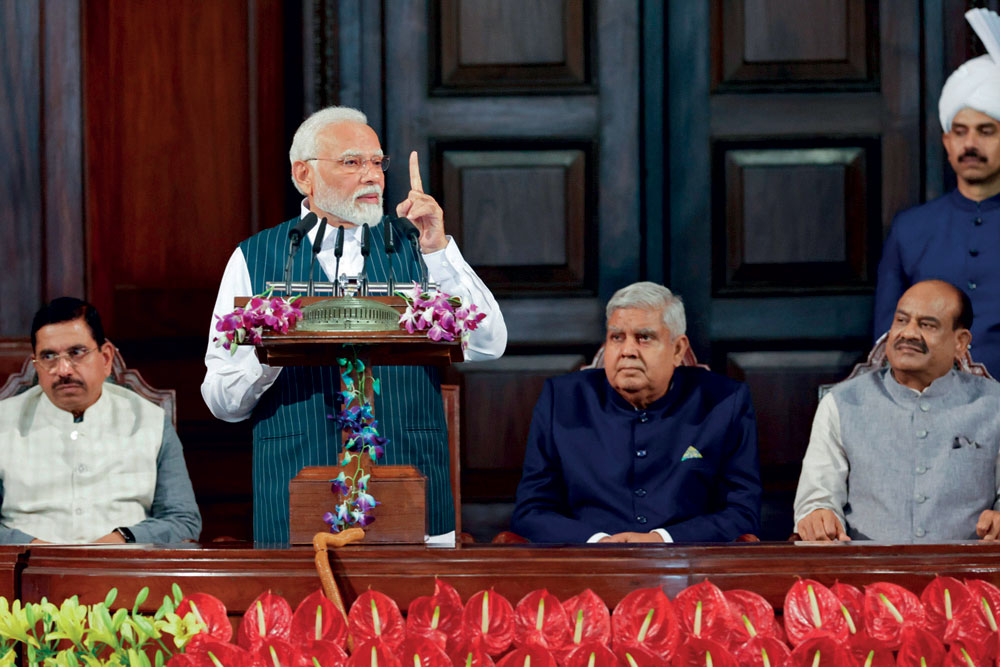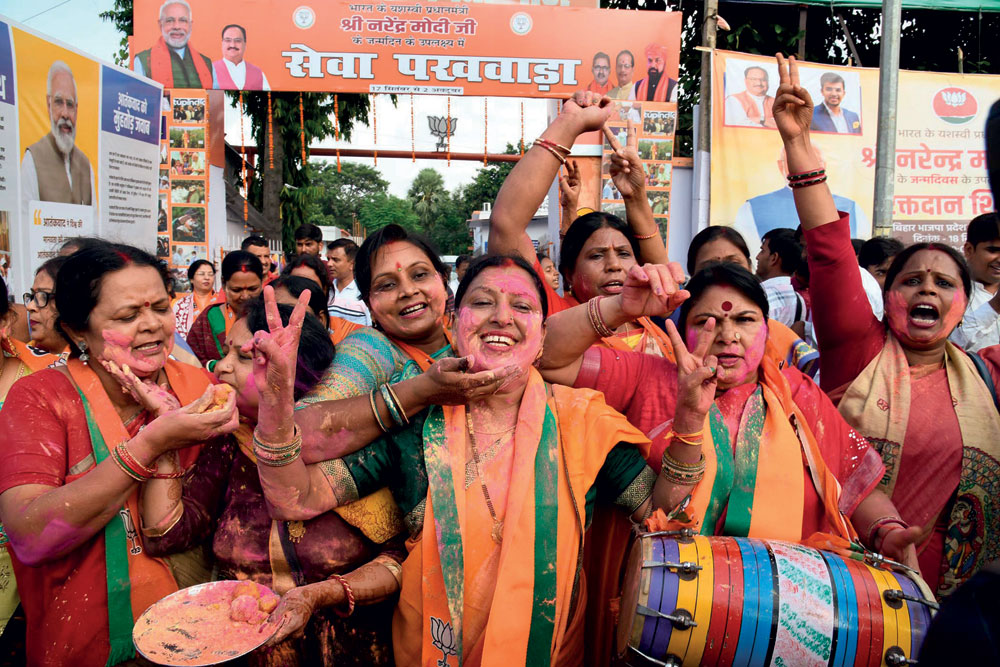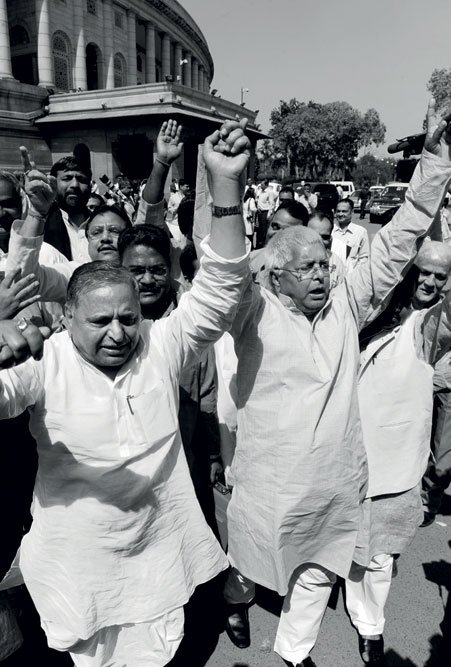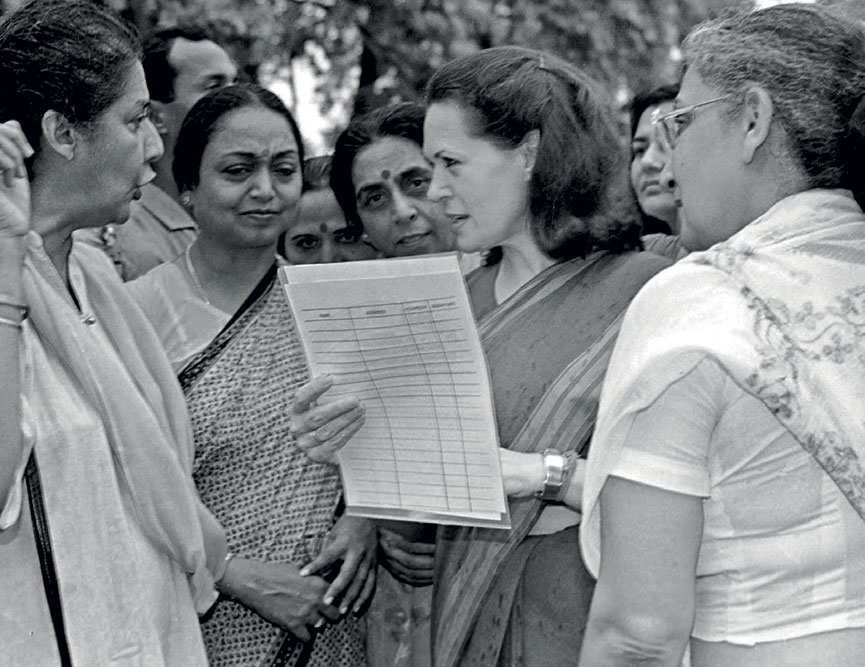The Great Power Shift
The overwhelming support for the Women’s Reservation Bill in Parliament marks the distance women have come in national life and is a big political victory for BJP
 Rajeev Deshpande
Rajeev Deshpande
 Rajeev Deshpande
Rajeev Deshpande
 |
22 Sep, 2023
|
22 Sep, 2023
/wp-content/uploads/2023/09/Powershift1.jpg)
Women MPs walk into the new Parliament building, September 19, 2023 (Photo: PTI)
The passage of the 128th Constitution Amendment Bill, providing 33 per cent reservation for women in Lok Sabha and state Assemblies on September 20 was remarkable not just for the overwhelming 454-2 margin. Every attempt to introduce the Bill in the House in the past had been met with physical resistance and confrontation. Papers were snatched from the hands of ministers seeking the Bill’s introduction and MPs scuffled and almost came to blows in the well of the House. Though numbers obviously matter in Parliament, the passage of the legislation hanging fire since 1996 has never been about arithmetic alone. The smooth adoption of the Nari Shakti Vandan Adhiniyam (Women Power Salutation Statute), barring the minuscule opposition of the All-India Majlis-e-Ittehadul Muslimeen(AIMIM), is a turning point, powered by the will of a government with a single-party majority, diminution of the legislation’s diehard opponents and, above all, a recognition of the rising participation of women in all walks of national life.
When the previous United Progressive Alliance (UPA) government moved the Bill (then the 108th Constitution Amendment Bill) in Rajya Sabha 13 years ago, it was resisted tooth and nail by Samajwadi Party (SP) and Rashtriya Janata Dal (RJD) MPs who squatted in the House and delayed voting by a day. The Mandal parties, led by the late Mulayam Singh Yadav and Lalu Prasad, were the bulwark of the opposition to the legislation. Mulayam Singh declared the Bill favoured only urban women and once ‘warned” fellow male MPs that they would be reduced to sitting on charpoys pulling at hookahs like village elders no one bothered about. The 2010 Bill was never subsequently moved in Lok Sabha. Not because of a lack of numbers as both the Left and the Bharatiya Janata Party (BJP) supported the legislation. But there were many more SP and RJD MPs in Lok Sabha besides the presence of both Mulayam and Lalu. While a majority of Janata Dal (United), or JD(U), MPs, then an ally of BJP, had voted for the Bill in the Upper House, party president Sharad Yadav (who once declared the quota would benefit “par kati”, or short-haired, women) was a Lok Sabha MP, and skilled at disruption. The Congress leadership blinked, not just due to SP and RJD warnings that they would quit UPA, but because of the real possibility of a bloody showdown. This was not an idle threat. In July 1998, when the Vajpayee government was in office, an RJD MP snatched papers from the speaker’s desk and the hands of then-Law Minister M Thambidurai before tearing them up. Present in the well were Mulayam and Lalu, pretty much directing operations. In contrast, there are just three SP MPs and no RJD MPs in the current Lok Sabha. The rise and consolidation of BJP in Uttar Pradesh (UP) has reduced SP to a marginal presence in the House while the BJP-JD(U) alliance shut out RJD in 2019.

The engaging discussion on the Bill, the first business to be conducted in the new Parliament building, saw Home Minister Amit Shah vigorously rebut the opposition’s allegations that the Bill was being brought to Parliament with an eye on the 2024 Lok Sabha polls and indicated nervousness in BJP ranks over the wages of incumbency ahead of seeking a third term. Shah spent some time dwelling on Prime Minister Narendra Modi’s women-centric decisions when he was chief minister of Gujarat, highlighting policies that dramatically reduced dropout rates for girl students and his gestures like handing over his savings for a corpus to help the female children of Gujarat government staff before leaving for New Delhi in 2014. “Women’s reservation and the cause of women is not a political matter for us. It is a matter of conviction and belief,” he said. The discussion in Lok Sabha (the Bill was passed by Rajya Sabha on September 21) saw the opposition make its points, with Trinamool Congress (TMC) MP Kakoli Ghosh questioning the government’s commitment to women’s empowerment by pointing to the controversy over women wrestlers who accused BJP MP Brij Bhushan Singh of sexual harassment and Dravida Munnetra Kazhagam’s (DMK) Kanimozhi decrying the ‘salutation’ in the Bill’s reference as objectivisation. Congress leader Sonia Gandhi said her late husband Rajiv Gandhi’s dream had been fulfilled and TMC’s Mahua Moitra said the Bill was a sham as there was no timeline. Yet, the political cut-and-thrust apart, most objections to the legislation were technical in nature and not much more than nitpicking. The passage of the legislation with practically no resistance was assured from the moment on September 19 when Modi announced it and appealed for unanimous support for it.
A third of seats will be reserved for women in Lok Sabha and state Assemblies within the General, Scheduled Caste and Scheduled Tribe categories. The quota will not extend to Rajya Sabha and Legislative Councils
A third of seats will be reserved for women in Lok Sabha and state Assemblies within the General, Scheduled Caste and Scheduled Tribe categories. The quota will not extend to Rajya Sabha and Legislative Councils
The long-awaited passage of the constitutional amendment is the first and most important step in realising the 33 per cent reservation, one that has repeatedly defied governments. Opposition leaders, including Sonia and Rahul Gandhi, questioned the need for a delimitation commission before the quota could be implemented as did others who said BJP was kicking the ball down the road. Shah addressed the question when participating in the debate, explaining that it will be the job of the delimitation commission to identify the seats that are to be reserved for women. It would do so after detailed consultations with all states and issuance of public notices. “How else will the seats to be reserved be decided?” he asked, adding, “If Wynad (represented by Rahul Gandhi) becomes reserved, you will say it is political.” It is clear that a delimitation commission, usually headed by a former judge of the Supreme Court and also comprising the Chief Election Commissioner, will be set up only after the 2024 General Election. The delimitation of seats will have to be on the basis of a fresh Census. The current exercise was opposed by anti-CAA (Citizenship Amendment Act) groups in 2019-20 and then the Covid pandemic delayed matters. Though various Covid-related restrictions were lifted in 2021, the “house listing” operations—collecting data on residences in a particular area—could not be taken up. In August 2001, Parliament had passed a constitutional amendment freezing the number and state-wise distribution of Lok Sabha seats till 2026. In doing so, it extended a similar decision of Parliament taken in 1976 and for the same reason— states which have successfully reduced population growth would be ‘punished’ by a loss of seats. So, the previous delimitation commission adjusted and rationalised the geographical spread of constituencies. In Delhi, for example, it reduced the outsized Outer Delhi seat and ensured constituencies were contiguous. It also used its powers to ensure the “tribal” character of certain seats in the Northeast was not altered by migration, much of it illegal, from Bangladesh. The recent delimitation in Assam and Jammu and Kashmir (J&K), states previously excluded from delimitation, raised similar issues. Congress said the delimitation in Assam “favoured” BJP, while Chief Minister Himanta Biswa Sarma said it would safeguard the state’s future. Article 82 of the Constitution states that every Census must be followed by the setting up of a delimitation commission. Apart from the legal and constitutional prescriptions, it makes little sense to implement the new reservation without the benefit of the most recent Census since the last decadal count was conducted in 2011.

But while the new-look Lok Sabha will be evident only after the 2029 elections (as per schedule) and the Bill clearly says current state Assemblies must run their course, the promise to increase female representation to 181 of 543 seats is simply breathtaking. A sense of elation among women MPs was evident on September 19 itself when the Bill was introduced by Law Minister Arjun Meghwal. After the day’s proceedings ended, MPs leaving the Lok Sabha chamber spoke of their expectations and the impact of the Bill. “This will greatly encourage women to seek roles in public life. They are participating in elections and governance in local bodies and can now see a career path at the higher level. I too came through a zila panchayat election and can understand how opportunities will grow,” said Riti Pathak, BJP MP from Sidhi in Madhya Pradesh. There had been incessant speculation among the political class and pundits since the government announced that a Special Session of Parliament would be convened in mid-September. It was evident, going by the political moorings of the BJP leadership, that the session would not be just a talkshop on 75 years of Parliament or a clutch of Bills. The Women’s Reservation Bill had been a millstone for all parties and used by the opposition to target the government of the day. For BJP, which supported the Bill in its previous incarnations, its passage ticks off another ‘sticky’ issue like the abrogation of Article 370 with regard to J&K. “The task of giving women their rights and using their abilities, this task… perhaps God has chosen me for several holy works,” Modi said in Lok Sabha on September 19. If there was a sense of manifest destiny in the prime minister’s words, he may not be much mistaken. The quota Bill has proved insurmountable for parties and leaders since it was first brought to Parliament by then Prime Minister HD Deve Gowda in 1996. Aware of the trenchant opposition within the United Front (UF) government, Gowda had reached out to Atal Bihari Vajpayee (then leader of the opposition in Lok Sabha), suggesting a 10 per cent reservation. Well aware of the contradictions within UF, Vajpayee saw no merit in considering the proposal.
A fresh Census will be followed by a delimitation commission that will decide which seats will be reserved and also redraw constituencies on the basis of latest population figures. This means the women’s quota will be effective from the 2029 Lok Sabha election as per the current schedule
The reservation will come into effect after the delimitation exercise for a period of 15 years and will then be reviewed
The main opposition to the legislation had come from leaders of the Other Backward Classes (OBCs) led by the redoubtable Mulayam and Lalu. The ‘Mandal twins’ were upfront in expressing their opposition, demanding a “quota within quota” for OBC women. They also called for a sub-quota for Muslim women. While OBC leaders did not hesitate to label the proposed reservation as pro-urban and anti-backward, their arguments provided cover to other opponents of the Bill who could not speak out for fear of being seen as anti-women or politically incorrect. It became a convenient excuse to bemoan the intractability of the Mandal parties and pay lip-service to the cause of women’s empowerment. Indeed, given the clout they enjoyed in successive governments, the OBC factor could not be wished away until BJP’s ascendance in 2014. There is a certain populist resonance to the backward argument which BJP ally and the minister of state (MoS) for commerce and industry expressed while supporting the Bill when she said women are not a homogenous grouping and there is social differentiation. Yet, the very same dynamics that accompanied the political rise of OBCs and resulted in greater representation in almost every party, including Congress and BJP, should help ensure an equitable distribution when the quota is implemented. The call to institute an OBC quota, however, is fraught as the Constitution does not provide for any such measure either for backwards or religious minorities. Members of Lok Sabha and state Assemblies are elected on the basis of three categories—General (including OBC), Scheduled Castes (SCs) and Scheduled Tribes (STs). Any legislation that does not adhere to these classifications will be vulnerable to legal challenge and a stay, a point emphasised by BJP MP Nishikant Dubey during the discussion on the 128th constitutional amendment. In recent years, attempts by some states to provide a quota for Muslims have failed to pass muster with the courts. The argument that the representation of Muslim women, already low, will be further hurt runs along similar lines. Parties claiming to represent the community remain male-dominated and, in fact, a one-third quota may force them to seek eligible Muslim women candidates. That might be the nub of their opposition. Overall, the oft-repeated excuse that it is difficult to find ‘winning’ women candidates will be undercut by reservation. Now parties have no choice but to find female nominees.


Taking note of speculation prior to the Special Session of Parliament, a meeting of the Congress Working Committee (CWC) had demanded passage of the Women’s Reservation Bill. What requires greater analysis is the party’s adoption of the OBC sub-quota demand that has largely been the preserve of Mandal outfits. This follows Congress calling for a caste-based Census, a point iterated by Rahul Gandhi, who even said the party will make public an exercise carried out by the UPA government if the demand is not accepted. He was referring to the 2011 socio-economic caste census. The findings of the census, however, could not be released as they were found to be flawed due to massive inaccuracies in categorisation and recording of castes. Congress’ lurch towards espousing the OBC cause could be intended to find fault with the current Bill even if such positioning ignores the fact that UPA’s 2010 legislation was no different. But there seems to be a larger repositioning that is a break from Congress’ more traditional centre-left politics. The leftward move has been evident since Rahul Gandhi took charge but the ‘backward’ tilt is newer and more pronounced. Over the years, Congress has been less successful in internalising the ascendance of OBCs as compared to BJP which has promoted backwards in its ranks and been agile in welcoming others from rival parties. BJP’s current dominance in UP would not have been possible without the support of OBCs who have previously favoured SP and to a lesser extent the Bahujan Samaj Party (BSP). The ascent of SP and RJD in UP and Bihar and the desertion of Muslims after the demolition of the Babri Masjid incapacitated Congress in the Hindi heartland and the party is yet to get out of a slump that has only deepened. The appeal to OBC sentiment is intended to sow doubts among communities which have become more ‘Hinduised’ in their political choices and are beneficiaries of the Modi government’s schemes, the latest being the PM Vishwakarma Yojana directed at artisans engaged in traditional crafts who largely hail from backward sections. While it is unclear how far Congress’ backward outreach will progress, it can solidify the impression that the party is moving farther away from its centrist roots that made it a catch-all outfit.
Rotation of seats for women will take place after each subsequent delimitation exercise
Despite higher participation in Panchayati Raj institutions, women’s participation in Assemblies and Parliament is low. With 78 women MPs, female representation in Lok Sabha is the highest ever but still unsatisfactory. It was 12 per cent in the previous Lok Sabha
Elections anywhere can hardly be taken for granted and BJP has shown a capacity to learn from mistakes as it did in 2019 when it moved to quell upper-caste discontent witnessed in state polls in late-2018 by swiftly legislating the Economically Weaker Section (EWS) quota which survived legal tests. Though the Karnataka result earlier this year was a localised event, unhappiness about inflation and sundry farm-related factors was evident. The Central government has since reduced cooking gas cylinder prices and provided additional subsidy for the Ujjwala scheme for poor households. As welfare schemes approach saturation, expectations rise and inflation poses a fresh challenge, the Modi government is not only devising ameliorative measures but taking decisions that can fire its political base afresh and even attract newer adherents. The Women’s Reservation Bill not only consolidates various Modi government initiatives that benefit women but is also an idea whose time has well and truly come.

/wp-content/uploads/2025/06/Cover-OpenMinds2025.jpg)












More Columns
Indian Companies Have a Ransomware Vulnerability Open
Liverpool star Diogo Jota dies in car crash days after wedding Open
'Gaza: Doctors Under Attack' lifts the veil on crimes against humanity Ullekh NP